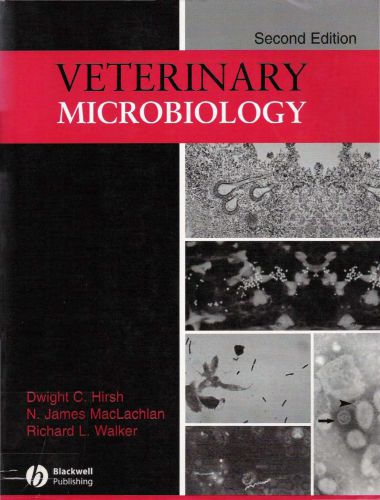Veterinary Microbiology 2nd Edition
by

The most recent revision of this comprehensive text covers the bacterial, fungal, and viral pathogenic agents that are significant causes of animal disease. The focus includes pathogenic mechanisms and processes in infectious diseases; methods of diagnosis; and principles of resistance, prevention, and therapy.
In addition to serving as a resource for veterinary students, Veterinary Microbiology, Second Edition also serves as a convenient reference for veterinarians and veterinary scientists whose main line of activity and expertise is outside the areas of microbiology.
Veterinary Microbiology, Second Edition is now organized in four sections according to the most appropriate methods of instruction:
Part I deals with the general characteristics of the host– parasite relationship, laboratory diagnosis of conditions involving an infectious etiology, antimicrobial treatment, and prevention of infectious disease.
Part II (Bacteria and Fungi) and Part III (viruses) present the infectious agents that affect the veterinary species. The chapters dealing with the bacterial agents are grouped mainly by morphology, and their gram-staining characteristics. The fungal agents are grouped mainly by morphologic characteristics (yeast, mold). The viruses are grouped along taxonomic grounds.
Part IV, an enhancement new to this edition, deals with the infectious agents in the context of the host. This section is organized by organ system. Each organ system is discussed first as a microbial habitat, followed by discussion of those infectious agents that mainly affect that particular system.
This book is intended for veterinary students, to accompany and supplement their first courses in pathogenic bacteriology-mycology and virology (Parts I through III), as well as subsequent courses dealing with infectious dis-eases (Part IV). The focus includes pathogenic mechanisms and processes in infectious diseases; methods of diagnosis; and principles of resistance, prevention, and therapy. A working knowledge of general microbiology is assumed.
Beyond serving as a resource for students, the book is also meant to serve as a convenient reference for veterinarians and veterinary scientists whose main line of activity and expertise is outside the areas of microbiology_ The book is divided into four sections. Part ! deals with the general characteristics of the host-parasite relation-ship, laboratory diagnosis of conditions involving an infectious etiology, antimicrobial treatment, and prevention of infectious disease. Parts H (bacteria and fungi) and III (viruses) present the infectious agents that affect the veterinary species.
The chapters dealing with the bacterial agents are grouped mainly by morphology, and their gram staining characteristics. The fungal agents are grouped mainly by morpho-logic characteristics (yeast, mold). The viruses are grouped along taxonomic grounds. Bacterial Skin Infections in Small Animals
Part IV deals with the infectious agents in the context of the host. This section is organized by organ system. Each organ system is discussed first as a microbial habitat, followed by discussion of those infectious agents that mainly affect that particular system. The content and organization of this book varies some-what from the last edition of Veterinary Microbiology (1999). Most notable is the organization of the infectious agents discussed in Part II, the bacteria and fungi. These agents are now discussed without regard to major organ system, but along more traditional grounds (La, morphology and gram reaction in the case of the bacterial agents, and yeast vs. mold for the fungal agents).
A major change in the content of this edition is the addition of Part IV, which deals with the infectious agents along more clinically useful lines. In addition, we have eliminated references from the end of each chapter. Aside from a space-saving device, almost universal access to the Internet and victual libraries make such references redundant. We gratefully acknowledge Natalie Karst, whose help is much appreciated. Special thanks go to Dede Andersen and lad Ringo of Blackwell Publishing, who have been un-believably patient and extremely helpful in getting our effort to press.
Direct Link For Paid Membership: –
This Book is Available For Premium Members Only (Register Here)
Unlock 3000+ Veterinary eBooks or Go To Free Download
Direct Link For Free Membership: –
| Book Name: | Veterinary Microbiology 2nd Edition | |
| File Size: | 88 MB | |
| File Format: | ||
| Download Link: | Click Here | |
| Password: | PDFLibrary.Net (if Required) | |
